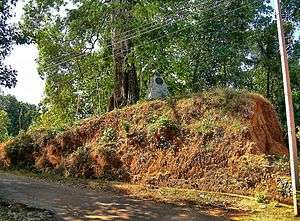Cochin–Travancore Alliance (1761)
|
The relics of the entrance of the famous Travancore Defense Lines at Palamuri, Chalakkudi. The Defense Lines were initially constructed to repel the Calicut forces | |
| Type | Peace treaty |
|---|---|
| Signed | 22-23, December 1761 |
| Parties | 2 |
The Cochin–Travancore Peace Treaty came to being in 1761 to expel the forces of the Zamorin of Calicut from the regions of the Kingdom of Cochin they had occupied in 1755-56. The alliance said that if the king of Travancore helps to regain the occupied territories, they can continue to keep the portions of Cochin they annexed during a period between 1755 and 1756. The famous Travancore Defence Lines were built as a result of this peace agreement.[1]
The allied forces of Travancore and Cochin completely defeated the Zamorin's army camped at Cranganore, Parur, and Verappalli resulting the rule of Travancore from Cape Comorin to Cranganore and the significantly diminishing of the territories of the Kingdom of Cochin. The forces of Travancore were led by Eustachius De Lannoy, the Flemish associated with a Battle of Colachel.[1]
Both Calicut and Travancore forces had marched to Cochin as soon as the Dutch effectively withdrew their support to Cochin. The Zamorin forces stormed from the north, and occupied Cranganore, Parur, Verappally, and Chettuva. Later, as a result of another treaty the Fort Chetwai was given back to the Dutch. The Travancore stormed Cochin from the south and occupied Thekkumkur, Vadakkumkur, and Purakkad.[1] Flanked under pressure by the two superior powers and having no Europeans to support, Cochin soon sued for a treaty with Travancore.
References
- 1 2 3 William Logan (1887). Malabar Manual. Asian Educational Services. ISBN 978-81-206-0446-9.
